Does the public notice public art? Not much in South Gyle it would seem, and there is a lot of it.
 “We were on assignment, trying to kill two birds with one stone. Destroy a piece of corporate art and trash a franchise coffee bar.” – Fight Club
“We were on assignment, trying to kill two birds with one stone. Destroy a piece of corporate art and trash a franchise coffee bar.” – Fight Club
In a memorable scene from the film Fight Club referred to as “Operation Latte Thunder”, a group of urban guerillas decide to destroy a franchise café by rolling a giant spherical corporate sculpture into it. The whole thing goes awry, ending up with the death of one of the main characters.
A similar hatred of corporate artworks is exhibited in the Simon Pegg vehicle, The World’s End. It is about a school reunion – and pub crawl – gone horribly wrong. The characters spend much of their time moaning about the changes that have occurred since 1990. One of these changes is an oddly bland looking metal figure about twenty or thirty foot tall. It features heavily in the plot later on, and not in a good way.
South Gyle is full of corporate and public artwork, some of which is more successful than others. Many of these artworks lack plaques, or any other obvious indications, as to where they came from. In these cases I have had to use nicknames or guess.
There is an odd sense of Soviet-style decay about some of these areas. For sure, the USSR fell in 1991, and a lot of these places seem to date from the early to mid nineties, but the decay is already there.
I apologise again for the quality of some of these images!
Lead in
Our journey begins on the South Gyle Access road, opposite Forrester Rugby Club. Here to the west, we see our first sculpture, a set of stainless tubes, which I call “the Pan Pipes”, reminscent of the Hallgrímskirkja in Reykjavik.

From the Flassches Yard (industrial estate) side, we see that the artwork is complimented by the inclusion of three metal bollards, which align perfectly with the symmetry of the Pan Pipes. The South Gyle Access side is obscured somewhat by a set of three young pines. It is unclear if the Pan Pipes are solar-aligned or not.
From here, we can proceed in two different directions:
- Along South Gyle Access. This leads us to the Lightning Roundabout, which is so called because of the fighter jet that used to be mounted on the top. There are three cedars at the top, and the footings of the pedestal can still be seen if you are brave enough to get on top of the roundabout (I don’t recommend it). The arms manufacturer has been replaced by Tesco Bank. From here, turn left onto South Gyle Crescent.

- Along Flassches Yard, which is the industrial estate to the rear of the Pan Pipes. This leads us by a mounted clock, the Big Ben of South Gyle, and straight onto South Gyle Crescent.
South Gyle Crescent
The first section of South Gyle Crescent takes us past one of several food vans. The first one is called the Chargrill Company, which sells a selection of hot meats and sits outside the College of Animal Welfare. (A similar juxtaposition can be seen over on Hanover Street where a branch of Oink Hog Roast sits above a health food store offering various vegan products).

Across the road, a bit further down is a Chinese takeaway van, which for some reason is called “Noduru”- a Japanese word, and which is also written in pseudo-Hiragana (a Japanese script). Japanese/Chinese – these daft westerners will never know the difference!

Behind one of the buildings, we find three endearing sculptures, one of a pigeon and two other birds. Their effect is somewhat undermined by the boarded fences nearby and the wasteland beyond, part of which is guarded by an entry post which would have not been out of place on the Iron Curtain.
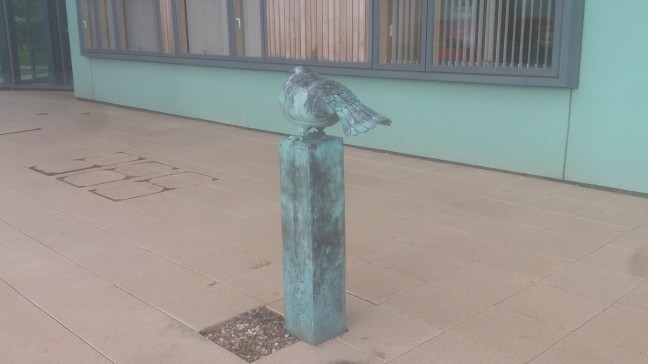


Sie verlassen den Amerikanischen Sektor… Papieren bitte!

Redheughs Avenue
We then walk down South Gyle Crescent, past the flying saucer like Bank of Scotland buildings, the well-hidden Edinburgh University archive library, until we reach a small roundabout, and the former headquarters of the Royal Bank of Scotland. Turn left here and you are on Redheughs Avenue.
Here we see easily the greatest artwork in South Gyle, Eduardo Paolozzi’s Wealth of Nations (1993). It is nicknamed by some people “the Chiseller” due to its proximity to the big bank building and the objects in its hands. Below its feet is a quote from Einstein, “Knowledge is good, but imagination is better”. If you’re going to look at any artwork in this area – check this out, and the herms of the poets in Edinburgh Park.

Further down on the left (south), one finds another sculpture outside an RBS building, this one I call “the Screw”. Perhaps another banking metaphor. I have never been right in to look at it, since there is a security guard posted at the gate, and hmm…

We then reach another roundabout, this one an attempt at some kind of Zen garden, basically gravel and large rocks scattered at random controlled by weedkiller.

Edinburgh Park
Edinburgh Park has a different feel to it. It begins just after “the Screw”, and is leafier. Most of the trees here too are stunted though. The bus shelter pictured used to have poetry on it many years ago, but this is all gone. There is a history of Edinburgh on it (and near another bus shelter further down), but you are more likely to see adverts for yoga here than literature these days.

Down at Loch Ross, the pond in the middle of Edinburgh Park, one can find the herms of numerous 20th century Scottish poets. Along with the Paolozzi behemoth, these are the most interesting artworks in South Gyle. This is the herm of Meester W.S. Graham. Another poet can be seen in the foreground. If you wish to know more about the sculptures, or see more pictures, you’ll have to buy the book!

“Told by an idiot, full of sound and fury, Cygnet-fying nothing…” – Shakespeare (kind of).
Wildlife occasionally wanders into Loch Ross. I have seen swans, geese, oystercatchers, moorhens and frogs in this area.

This could be just about anywhere…
A moorhen…

And yes, I had to photograph one of these. We paid enough, didn’t we?

How’s that Zen Garden working for you? (It is unknown if the owners of Nudoru Chinese takeaway contributed to this landscape sculpture in any form.)
The Gyle Centre
The artistic contents of this carparks include a kinetic sculpture which no longer moves…

A mottled cube called Concrete Jungle by Alan Watson (1994)…

Stacked Stades by Marion Smith (1994)…
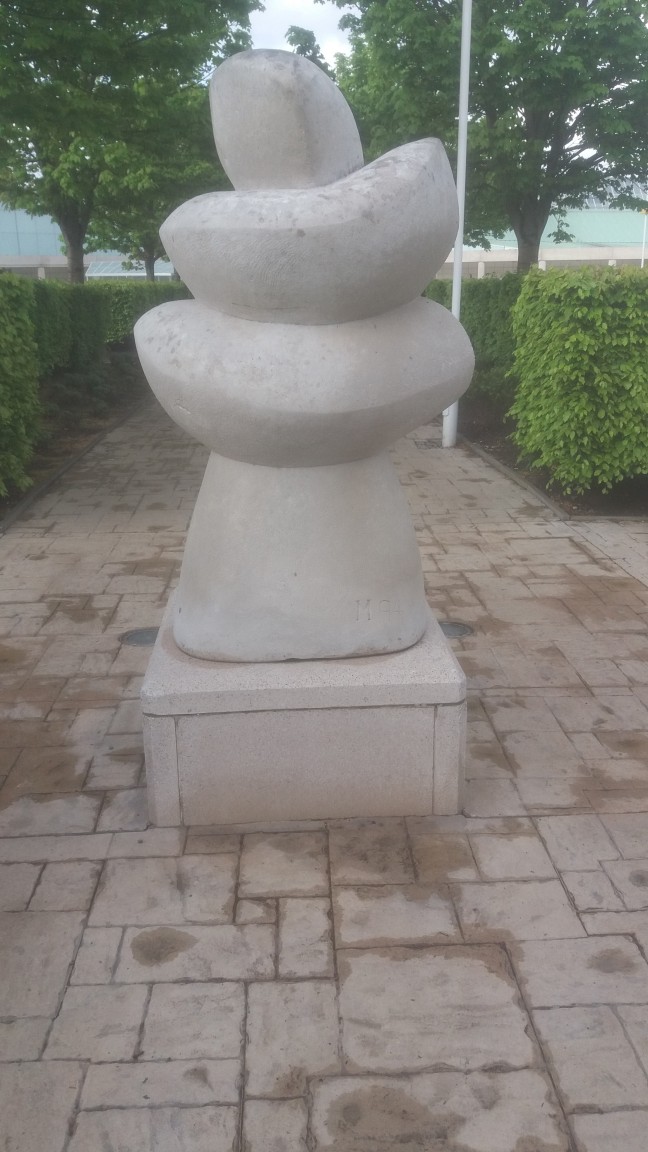
A former fountain and waterway, now filled in with plants…
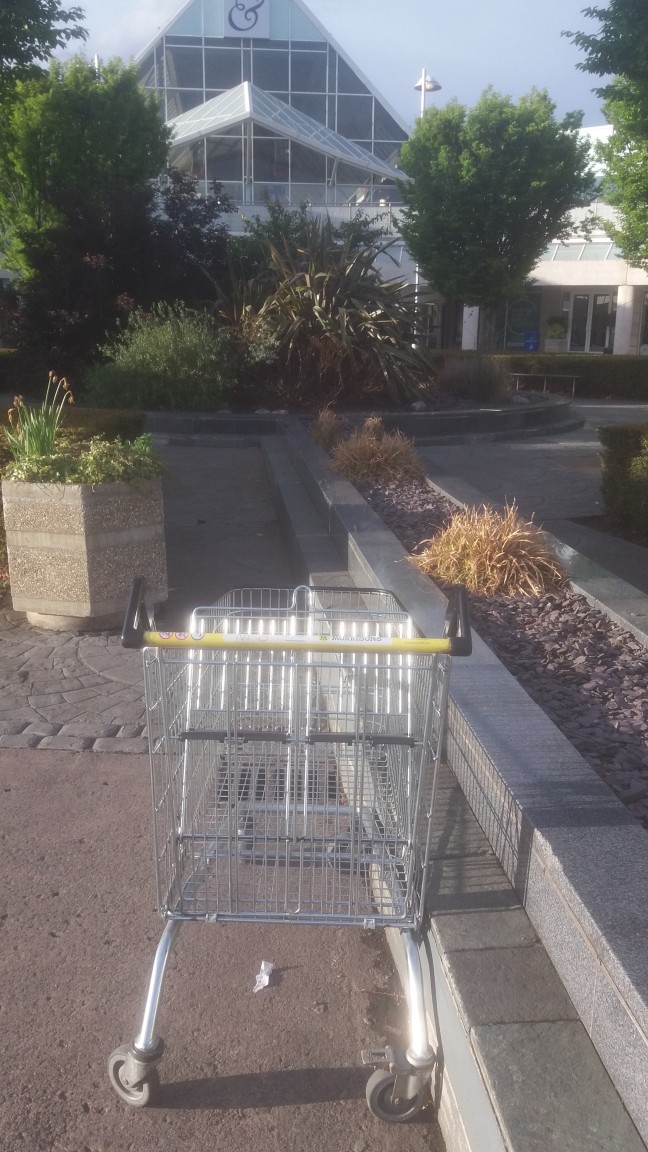 A giant chessboard near the bus stops, which I have never seen anyone use in over twenty years… although you can apparently request giant chess pieces inside the centre.
A giant chessboard near the bus stops, which I have never seen anyone use in over twenty years… although you can apparently request giant chess pieces inside the centre.
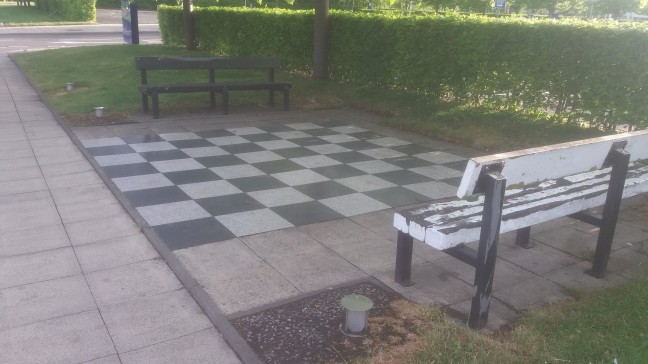
There is also a metal relief map of the Gyle Centre.

Who knows what this is? The plaque is missing and no one has bothered replacing it for years on end. Note the face at the top. Presumably 1994 like the rest…

Veil by Jake Kempsall (1994)…

Fossil Tree by Bill Scott (1994)… a hard one to photograph, surrounded by bins, lights and hedges.
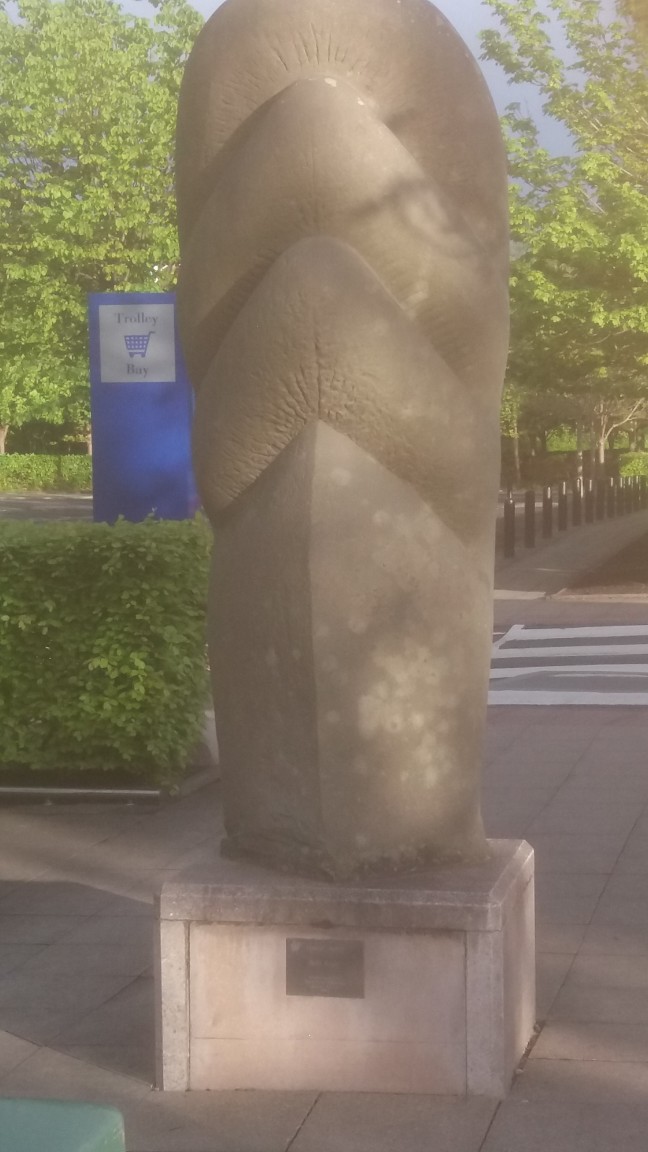
Ian Hamilton Finlay?
Near the Gyle Centre Petrol Station, we encounter this structure. The basic form suggests a Greek temple. Inside are a set of Stelae which resemble Ian Hamilton Finlay’s work. The inscriptions are hard to read but refer to the likes of Ariel and Hesperus. These deserve a return visit from me, but I didn’t have much time to look at them. I have seen them many times before, thought they were just bollards and never properly considered them.










Appendix: The Badlands of South Gyle
This is the area to the north of Edinburgh Park Station. It is not really worth visiting. Here you can find numerous spaces which have been empty for years. There is a large substation, with some trees, what look like crosses between bomb sites and rice paddies. Happily this area has been colonised by spiky teazles.
More bizarrely two hotels overlook this wasteland.

Teazles – dipsacus – a plant formerly used in wool carding and a good coloniser of the badlands. Other flowers and rushes have colonised a few areas.
Other flowers and rushes have colonised a few areas.



 Burdock and broom…
Burdock and broom…
And here is a mysterious pay car park in the middle of nowhere.

And a rarely used putting green near Loch Ross and the Edinburgh Park Central tram stop.
In case anyone is interested, the Lightning ⚡ which used to sit on the roundabout at Ferranti’s is now at the Dumfries and Galloway Aviation Museum, Dumfries.
LikeLiked by 1 person
Does anyone know why Paolozzi’s Wealth of Nations has been removed?
LikeLiked by 1 person
Has it?! It did have a fence around it a while back.
LikeLiked by 1 person
I think RBS has probably taken it elsewhere or sold it on, since demolishing their Redheughs headquarters. I wonder if it is in Gogarburn now.
LikeLike